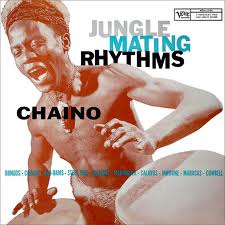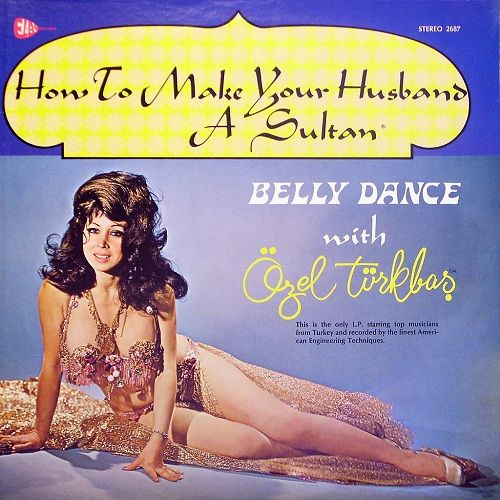
Growing up, Chaino’s face was always around, floating in and out of the amazing collection of LPs and reel-to-reel tapes my Dad had accumulated before marriage. Every now and then, we’d plop it on the turntable and groove to raw African beats, churned through a mesh of steel drums, slapping palms, shakers, bongos, and moaning voices (yes, moans!) Never stopped to think about which African country Chaino was from – “just Africa” was enough for us. The convincingly tribal LP cover sealed the deal – Chaino was real in our minds.
Chaino: Safari Jungle Maze
[audio:http://stuckbetweenstations.org/wp-content/uploads/2011/09/09-Safari-Jungle-Maze.mp3]
40 years later, while digitizing the LP collection, took time for the first time to, you know, actually read the liner notes:
“Chaino is the only survivor of a lost race of people from the wilds of the jungle in a remote part of central Africa where few white men have ever been… [he was discovered as a boy in] the remnants of what had been a native village. Surrounding hostile tribes had attacked the village and massacred its inhabitants. They found only a small boy near death starving amongst the ruins…”
Full liner notes here.
 Add to that a closer study of the track titles (“Torture of the Mau-Mau?” Really?) and my B.S. detectors finally went off. Clearly the Chaino story was fiction, written for a white audience seeking exotic audio adventures on their home Hi-Fi sets. Vinyl and accompanying literature for the armchair traveler. But if the story and photography were all fabricated, then how to explain the music, which is pretty darned authentic sounding? A quick search turned the truth up to 11:
Add to that a closer study of the track titles (“Torture of the Mau-Mau?” Really?) and my B.S. detectors finally went off. Clearly the Chaino story was fiction, written for a white audience seeking exotic audio adventures on their home Hi-Fi sets. Vinyl and accompanying literature for the armchair traveler. But if the story and photography were all fabricated, then how to explain the music, which is pretty darned authentic sounding? A quick search turned the truth up to 11:
The self-styled “percussion genius of Africa,” exotica-era enigma Chaino was actually born Leon Johnson in Philadelphia in 1927; raised primarily in Chicago, the details of his early life are largely a mystery … following surgery to remove a brain tumor, he suffered a fatal heart attack on July 8, 1999.
Chaino was a brilliant drummer, but he was an American drummer riding the exotica wave of the 1950s and 60s (and who wouldn’t?). But leaving aside multilayered and complicated questions of identity, he was an awesome percussionist, and clearly knew his way around African rhythms. Unlike Martin Denny and a lot of the exotica scene, Chaino was not some white guy pretending to sound African – somewhere along the way, Chaino got real. But he still chose to present himself as a cultural fiction… as something not quite from Chicago.

Somewhere in my wild and somewhat random record-collecting teens, I happened on this LP by Özel Türkbas – How To Make Your Husband a Sultan. OK, truth out: I probably bought it for the cover. But through it, I discovered the wonders of actual Turkish belly dance music.
Özel Türkbas: Andalou Asia Minor:
[audio:http://stuckbetweenstations.org/wp-content/uploads/2011/09/07-Anadolu-Asia-Minor.mp3]
The coolest thing about the record is that it comes with a little pamphlet (which I still have) demonstrating exactly how to make your husband a sultan, i.e. how to pretend to belly dance for your husband. The pretense that a suburban American housewife could convincingly learn an ancient art from an eight-page pamphlet is ridiculous of course; its real purpose was to provide an excuse to show off Türkbas’ mighty assets through the convincing guise of cultural education. I have a feeling the pamphlet was deployed more frequently for ogling than for training.

Where Chaino and Türkbas disconnect is that her record is the real deal – these are real Turkish musicians playing fantastic Turkish belly dancing music – the kind you’d be likely to hear in any authentic belly dancing nightshow or club in 1969. Turns out the book 1,000 Recordings To Hear Before You Die profiled it a while back:
Put this on, and the first image isn’t of some scantily dressed cosmopolitan housewife of the era sashaying around snapping finger cymbals. It’s more like a public celebration or a scene from a bustling dance hall, where the band is cranking out brisk, precise music that has everybody moving. Built around the wizardry of clarinetist Mustafa Kandıralı, this ensemble slithers and undulates, creating swirling waves of hypnotic rhythm. Several pieces leave room for improvised variations, and that’s where things heat up. Kandıralı and violinist Cevdet ÇaÄŸla keep the dance rhythm going while unspooling extended technically demanding embellishments. Like the swing-era musicians who had more to offer than “In the Mood,” they manage to slip in subversive, jaw-dropping runs without shirking their main responsibility, accompanying dancers.
Here’s the difference: While Chaino was channeling pretty-much-believable African music through a fake African identity, Türkbas put together real Turkish belly dancing ensemble, but packaged it simplistically for an American audience eager to become a bit more cosmo by indulging in harmless middle eastern fantasy. “Oooh, so exotic!” Still, both are in a totally different category from Martin Denny and Arthur Lyman, who pretty much faked the whole thing along with the rest of the exotica movement*.
* Don’t mean to dish on Denny here – he’s a hero to me. More on him later.
Big chin wag to Hermenaut #15 – the legendary False Authenticity issue.
Great post. Chaino was an authentic Chicagoan with authentic percussion skills, and that’s good enough for me. I love the Turkish record, but not seeing it as that different. In both cases, the record company’s marketers decided that padding the image with some “exotic” element would help sales.
I’m too much of a former Boy Scout to condone the invented biography. But if we judged artists on their truth-telling, the list could get pretty short. I remember reading about how folk archivists wanted Leadbelly to sing about prison and tone down his familiarity with “white” music. Beethoven’s dad allegedly lied about the age of his young piano prodigy, hoping that he’d be considered the next Mozart.
That’s fascinating about Leadbelly (Huddy Ledbetter?) I think we could have a field day on invented biographies and false authenticity/ethnography.
Come on Donny Osmond – what’s your *real* story?